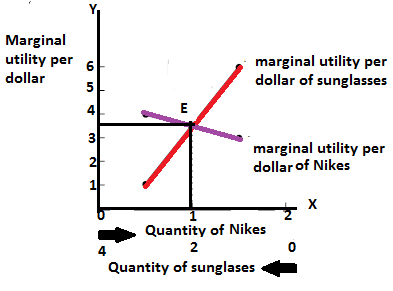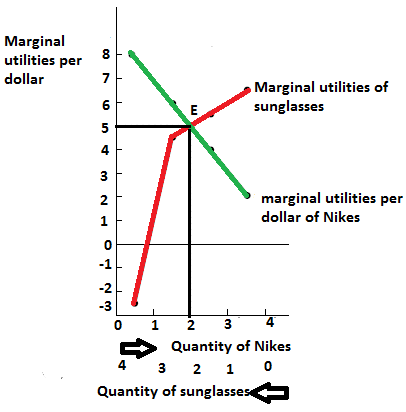
To answer:
The questions based on the given situations
Concept Introduction:
Marginal utility: This is the additional benefit or satisfaction derived from the consumption of an additional unit of a commodity or service.
Utility: This is the benefit or satisfaction derived from the consumption of a good or service
Explanation of Solution
- Cal’s consumption bundle consists of the following
- The available consumption bundle for Cal is the following. These bundles lies on the budget line of Cal’s
- Cal’s consumption of Nikes increases from 1 to 2 as the price of Nikes falls. This is because of two effects, the substitution effect and income effect. The substitution effect says that as the price of Nikes falls, their
opportunity cost falls so Cal now has to give up fewer pairs of sunglasses for 1 Nike. This makes Nikes more attractive, and Cal substitutes Nikes in place of sunglasses. The income effect says that as Nikes become cheaper, Cal gets richer in a real sense; he can now buy more goods. Since Nikes are a normal good, when thepurchasing power of Cal’s income rises, he consumes more Nikes. Both effects contribute to the fact that as the price of Nikes falls, Cal’s consumption of Nikes increases.
 Nikes,
Nikes,  sunglasses
sunglasses
 Nike,
Nike,  sunglasses
sunglasses
 Nike,
Nike,  sunglasses
sunglasses

The above diagram shows the marginal utilities per dollar of Nikes and Sunglasses, the intersection between these points shows the optimal choice for Cal, the optimal point is denoted by the capital letter ‘E’. The quantity of Nikes is measured from left to right and the quantity of sunglasses measured from right to left on the horizontal axis. In the vertical axis the marginal utilities per dollar of both Nikes and Sunglasses are measured. Of the entire possible consumption bundle Cal could consume bundle that contains  Nike and
Nike and  sunglasses. It is considered as the optimal consumption bundle, in this bundle the marginal utility per dollar spent on Nikes and marginal utility per dollar spent on Sunglasses are equal so it is the optimum consumption bundle.
sunglasses. It is considered as the optimal consumption bundle, in this bundle the marginal utility per dollar spent on Nikes and marginal utility per dollar spent on Sunglasses are equal so it is the optimum consumption bundle.
 Nikes,
Nikes,  sunglasses
sunglasses
 Nikes,
Nikes,  sunglasses
sunglasses
 Nikes,
Nikes,  sunglasses
sunglasses
 Nikes,
Nikes,  sunglasses
sunglasses
`4 Nikes,  sunglasses
sunglasses
| Quantity of Nikes | Utility from Nikes | Marginal utility of Nikes | Marginal utility per dollar | Quantity of sunglasses | Utility of sunglasses | Marginal utility of sunglasses | Marginal utility per dollar |
 |
 |
- | - |  |
 |
- | - |
 |
 |
 |
 |
 |
 |
 |
 |
 |
 |
 |
 |
 |
 |
 |
 |
 |
 |
 |
 |
 |
 |
 |
 |
 |
 |
 |
 |
 |
 |
 |
 |
The above table shows the marginal utility of both Nikes and Sunglasses and the marginal utilities per dollar of Nikes and sunglasses.

The above graph shows the marginal utilities per dollar spent on Nikes and Sunglasses, the intersection between these  so it is considered as the optimal choice for him.
so it is considered as the optimal choice for him.
Want to see more full solutions like this?
Chapter 10 Solutions
Loose-leaf Version For Microeconomics
- M” method Given the following model, solve by the method of “M”. (see image)arrow_forwardAs indicated in the attached image, U.S. earnings for high- and low-skill workers as measured by educational attainment began diverging in the 1980s. The remaining questions in this problem set use the model for the labor market developed in class to walk through potential explanations for this trend. 1. Assume that there are just two types of workers, low- and high-skill. As a result, there are two labor markets: supply and demand for low-skill workers and supply and demand for high-skill workers. Using two carefully drawn labor-market figures, show that an increase in the demand for high skill workers can explain an increase in the relative wage of high-skill workers. 2. Using the same assumptions as in the previous question, use two carefully drawn labor-market figures to show that an increase in the supply of low-skill workers can explain an increase in the relative wage of high-skill workers.arrow_forwardPublished in 1980, the book Free to Choose discusses how economists Milton Friedman and Rose Friedman proposed a one-sided view of the benefits of a voucher system. However, there are other economists who disagree about the potential effects of a voucher system.arrow_forward
- The following diagram illustrates the demand and marginal revenue curves facing a monopoly in an industry with no economies or diseconomies of scale. In the short and long run, MC = ATC. a. Calculate the values of profit, consumer surplus, and deadweight loss, and illustrate these on the graph. b. Repeat the calculations in part a, but now assume the monopoly is able to practice perfect price discrimination.arrow_forwardThe projects under the 'Build, Build, Build' program: how these projects improve connectivity and ease of doing business in the Philippines?arrow_forwardhow utillity relate to microeconomics ?arrow_forward
- How Command Economics Relate to Principle Of Economics?arrow_forwardhow commond economies relate to principle Of Economics ?arrow_forwardCritically analyse the five (5) characteristics of Ubuntu and provide examples of how they apply to the National Health Insurance (NHI) in South Africa.arrow_forward

 Principles of Economics (12th Edition)EconomicsISBN:9780134078779Author:Karl E. Case, Ray C. Fair, Sharon E. OsterPublisher:PEARSON
Principles of Economics (12th Edition)EconomicsISBN:9780134078779Author:Karl E. Case, Ray C. Fair, Sharon E. OsterPublisher:PEARSON Engineering Economy (17th Edition)EconomicsISBN:9780134870069Author:William G. Sullivan, Elin M. Wicks, C. Patrick KoellingPublisher:PEARSON
Engineering Economy (17th Edition)EconomicsISBN:9780134870069Author:William G. Sullivan, Elin M. Wicks, C. Patrick KoellingPublisher:PEARSON Principles of Economics (MindTap Course List)EconomicsISBN:9781305585126Author:N. Gregory MankiwPublisher:Cengage Learning
Principles of Economics (MindTap Course List)EconomicsISBN:9781305585126Author:N. Gregory MankiwPublisher:Cengage Learning Managerial Economics: A Problem Solving ApproachEconomicsISBN:9781337106665Author:Luke M. Froeb, Brian T. McCann, Michael R. Ward, Mike ShorPublisher:Cengage Learning
Managerial Economics: A Problem Solving ApproachEconomicsISBN:9781337106665Author:Luke M. Froeb, Brian T. McCann, Michael R. Ward, Mike ShorPublisher:Cengage Learning Managerial Economics & Business Strategy (Mcgraw-...EconomicsISBN:9781259290619Author:Michael Baye, Jeff PrincePublisher:McGraw-Hill Education
Managerial Economics & Business Strategy (Mcgraw-...EconomicsISBN:9781259290619Author:Michael Baye, Jeff PrincePublisher:McGraw-Hill Education





